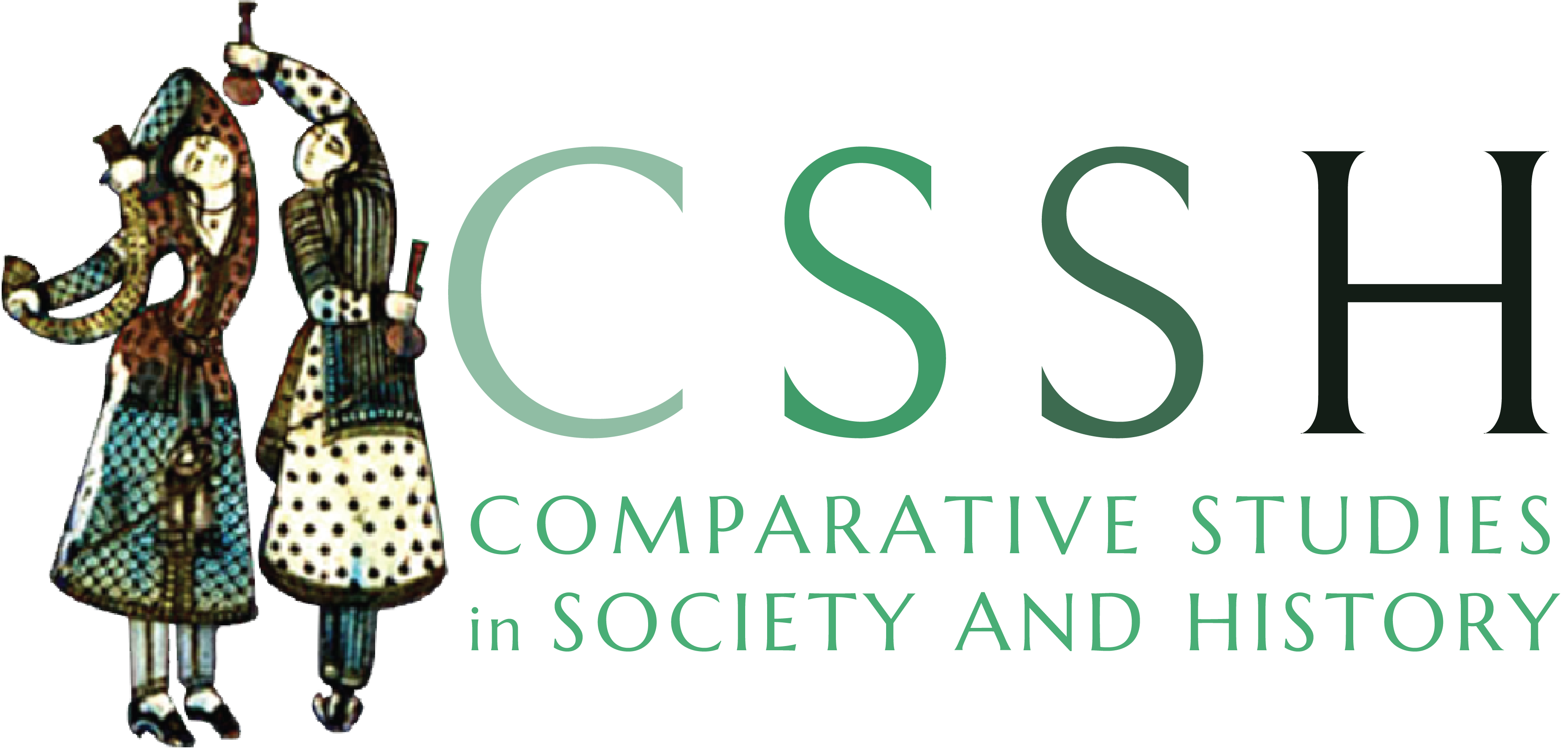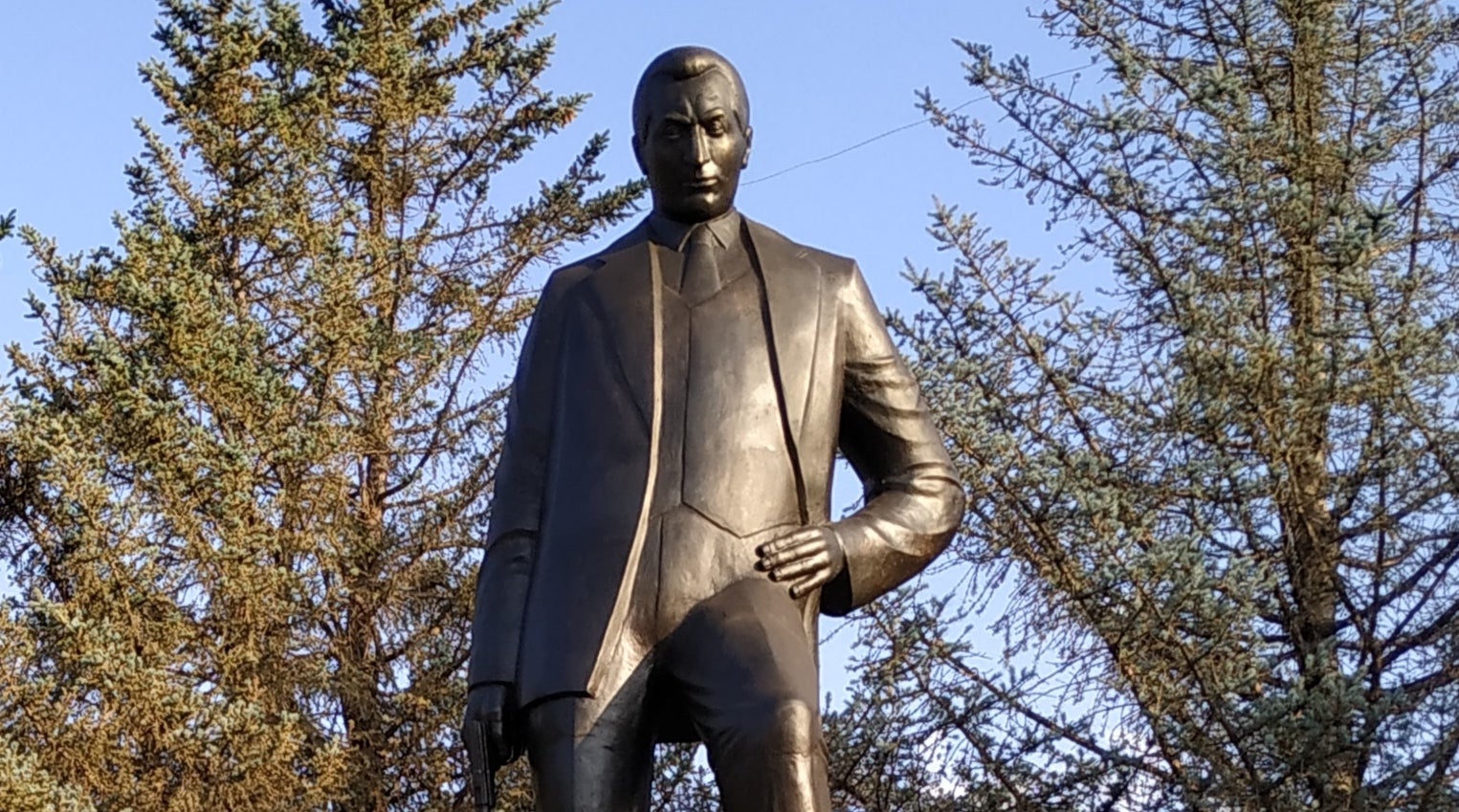Alp Yenen’s recent CSSH article, “The Talat-Tehlirian Complex: Contentious Narratives of Martyrdom and Revenge in Post-Conflict Societies” (64-2, 2022), discusses why the celebration of heroes who are martyred and heroes who have avenged martyrs play a vital role in sustaining conflicts. By deciphering a specific configuration in the conflicting legacies of the Armenian Genocide, Yenen demonstrates how martyrdom and revenge are coupled with one another in competition for the sacralization of dying and killing, further aggravating the reconciliation of Turkish-Armenian relations. Yenen calls for a post-heroic rethinking of history and memory to overcome what he calls the martyr-avenger complex that plagues post-conflict societies. Here, in his “Behind the Scenes” entry, Yenen talks about how the political reputations of historical figures as heroes and villains in contemporary societies complicate historical studies.
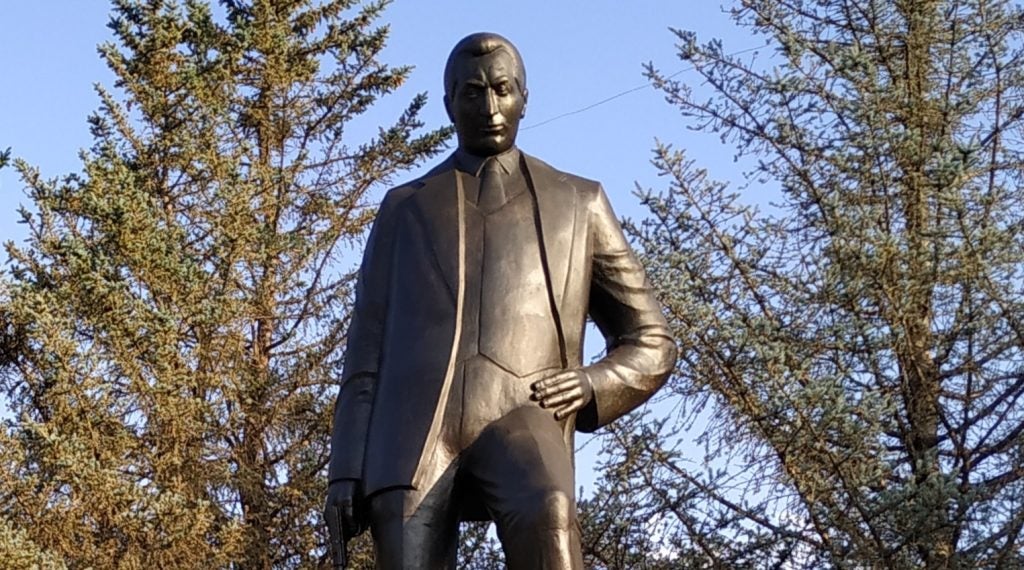
Historians have a weak spot for transgressive actors. Extraordinary people who challenge and change the norms of their time – for better or worse – catch the attention of those who attempt to map human agency across world history. I am no exception. I happen to be working on one such group, erstwhile revolutionary dissidents who would end up ruling a crumbling empire as reckless despots, only to run away as rogue desperados attempting to redeem themselves in the changing world order after the First World War.
One of the transgressive actors I’ve been examining is Mehmed Talat. As one of the oppositional leaders of the constitutional revolution of 1908, he would become Interior Minister and Grand Vizier of the Ottoman Empire. Once in power, Talat Pasha—a skillful mediator between various factions within the “Young Turk” Committee of Union and Progress—was complicit in some of the most radical and reprehensive policies of this regime. Most notably, as the Interior Minister, Talat managed the genocidal displacement and persecution of over a million Ottoman Armenians in 1915 under the pretense of war-time security measures. After a devastating Ottoman defeat in the First World War and anticipating court-martials, Talat and his accomplices escaped to Berlin. There, they conspired with political dissidents from across the globe and campaigned for revolutionary anticolonialism in the Muslim world in hopes of returning to power in the new Turkey. On March 15, 1921, in the midst of his political regrouping, Talat was murdered in broad daylight by a young Armenian named Soghomon Tehlirian, the hitman of a secret Armenian assassination squad called Operation Nemesis that was set up to avenge the crimes committed against the Armenian people.
Although I’ve been primarily occupied with uncovering Talat’s transnational diplomacy and subversive activities within the global history of the peace settlement after the First World War, I had to face the fact from the beginning that Talat is a burdensome protagonist. Talat is either a hero or a villain in contentious narratives that fiercely contend with each other over morality and veracity. However, Talat is a burdensome protagonist not only because he was the “architect of the Armenian Genocide” – a popular moniker that I, the son of two architects, personally find very misleading. Talat’s central responsibility in the crimes committed against the Armenians is undeniable, but if we shall insist on using metaphors from civil engineering then I would argue that Talat’s role more resembled that of a property developer (in Turkish: müteahhit) managing the whole ordeal than a visionary architect (mimar) with mere blueprints. Semantics aside, as I’ve argued in my CSSH article, Talat’s heroization and villanization is not only about his role in what happened to Armenians in Anatolia in 1915, but also about what happened to him in Berlin in 1921.
The symbolic legacy of Talat’s revenge killing by an Armenian survivor,[i] turning Talat into a martyr in the eyes of his supporters, combined with the fact that his murderer was acquitted by the court, has considerably shaped his posthumous reputation. Talat and Tehlirian are a peculiar pairing in history and memory, one that couples a martyr and an avenger in which both are simultaneously each other’s perpetrator and victim. I have dubbed this phenomenon a “martyr-avenger complex,” a mutual framework of sensemaking that demands solidarity, sustains grievances, and sacralizes violence in post-conflict societies. Hence, my research on Talat’s political trajectory in the final years of his life was further complicated by conflicting legacies of the Talat-Tehlirian complex.
However, as I have argued in my article, Talat’s official heroization as a national martyr—despite its otherwise appealing anti-imperialist and anti-minoritarian undertones–never received popular support in Turkey. The Turkish state considerably increased the commemoration of Talat’s martyrdom in reaction to Armenian terrorist attacks against Turkish foreign representatives in the 1970s and 1980s. Even so, Talat was still detested by conservative Turkish nationalists as one of the harbingers of doom to the glorious Ottoman Empire and to the idealized Sultan Abdülhamid II, who was deposed by Talat and his Young Turk colleagues. Many years ago, in the early stages of my research, a Turkish professor whom I had just met at the Ottoman archives in Istanbul had warned me, apropos of nothing, about men like Talat who, in his words, were nothing but “crypto-Jews, Freemasons, and Zionists”.[ii] Those who are familiar with the rich culture of conspiracy theories in Turkey will know that such depictions of Talat originate from Islamist popular histories of the 1950s. Beyond the Armenian Genocide, therefore, Talat’s heroization is a matter of contention also among various Turkish nationalist factions in making sense of the triumphant yet traumatic transformation of the Ottoman Empire to the Turkish Republic.
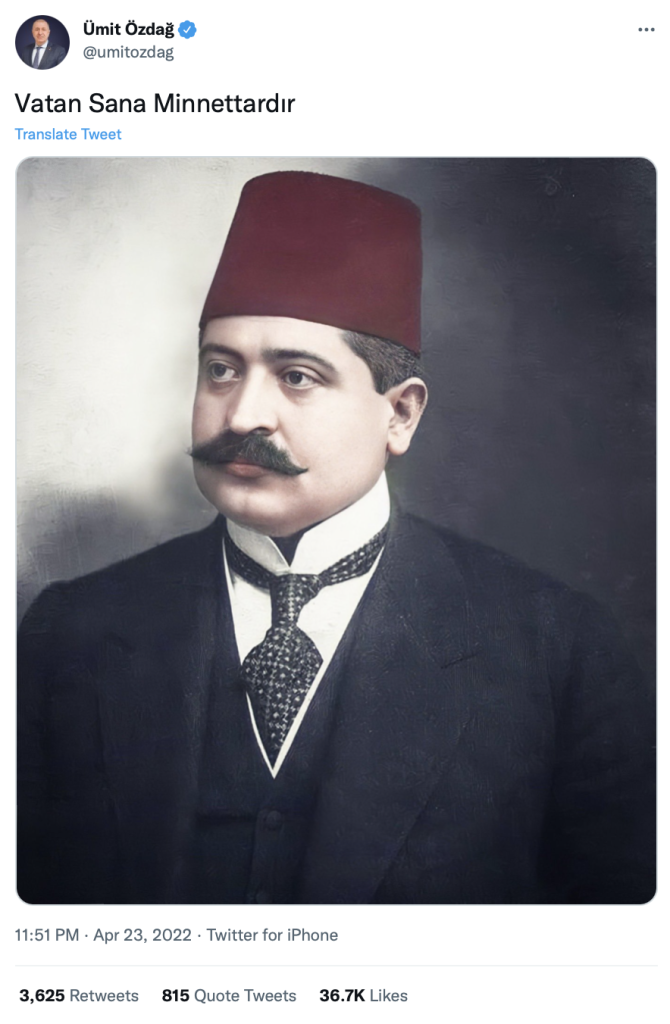
Yet, I’ve also noted in my article that there are indicators of a growing trend in Turkey toward a coalition between Islamists and ultranationalists based on notions of imperial revanchism, in which Talat is being rehabilitated for the popular conservative masses as a martyred hero. After the publication of my article in early 2022, social media posts during the 101st anniversary of Talat’s assassination on March 15 and the 107th anniversary of the Armenian Genocide on April 24, provided a plenty of new evidence confirming my hapless prognosis. Turkish social media was filled with posts of Talat Pasha’s photographs, captioned with prideful eulogies of his heroic martyrdom in the name of the Turkish state and nation. Celebrating Talat as a martyr constitutes a provocative speech act that not only denies the suffering of Armenians and depicts them as traitors and terrorists, but also sacralizes killing and dying in the name of the Turkish state and nation. In memory of the assassination of Turkish-Armenian journalist Hrant Dink in 2007, which was a reverse reenactment of Talat’s assassination by Tehlirian, such speech acts are very sad and indeed scary. Many scholars and historians, such as İlker Aytürk from Bilkent University and Ali Yaycıoğlu from Stanford, wondered in their social media posts about the unprecedented recent popularity of Talat in Turkey.[iii] Especially prominent was the post of the far-right, anti-migration splinter party leader, Ümit Özdağ, who tweeted a photo of Talat Pasha with the text “The Homeland is Grateful to You” on the day of the genocide commemoration. This post received nearly 37 thousand likes on Twitter and hundreds of celebratory retweets.[iv] Armenian nationalists who retweeted Özdağ featured in return photos of Soghomon Tehlirian that celebrated him as a righteous avenger, commonly accompanied with the popular saying that Tehlirian was no murderer, for he killed a mass murderer. One of the most controversial reactions came in the form of a tweet by the Istanbul branch of the Socialist Refoundation Party (Sosyalist Yeniden Kuruluş Partisi) a Marxist-Leninist fringe party: “We Will Become Soghomon Tehlirian to Those Who Become Talat Pasha!,” said the tweet, redubbing the tweeted photo of a street banner with the same slogan. It continued: “Those who emulate the genocidal gangs on the anniversary of the Armenian Genocide should know that they will find revolutionaries defending the brotherhood of peoples against them!”[v] In the face of these incidents, genocide scholar Yektan Türkyılmaz kindly shared my article and tweeted: “It’s a rare situation. This very valuable article of @alp_yenen is literally being staged on the streets and on social media.”[vi] I wish I had been wrong, but the martyr-avenger complex still haunts Turkish-Armenian relations in these depressing times of vulgar populism.
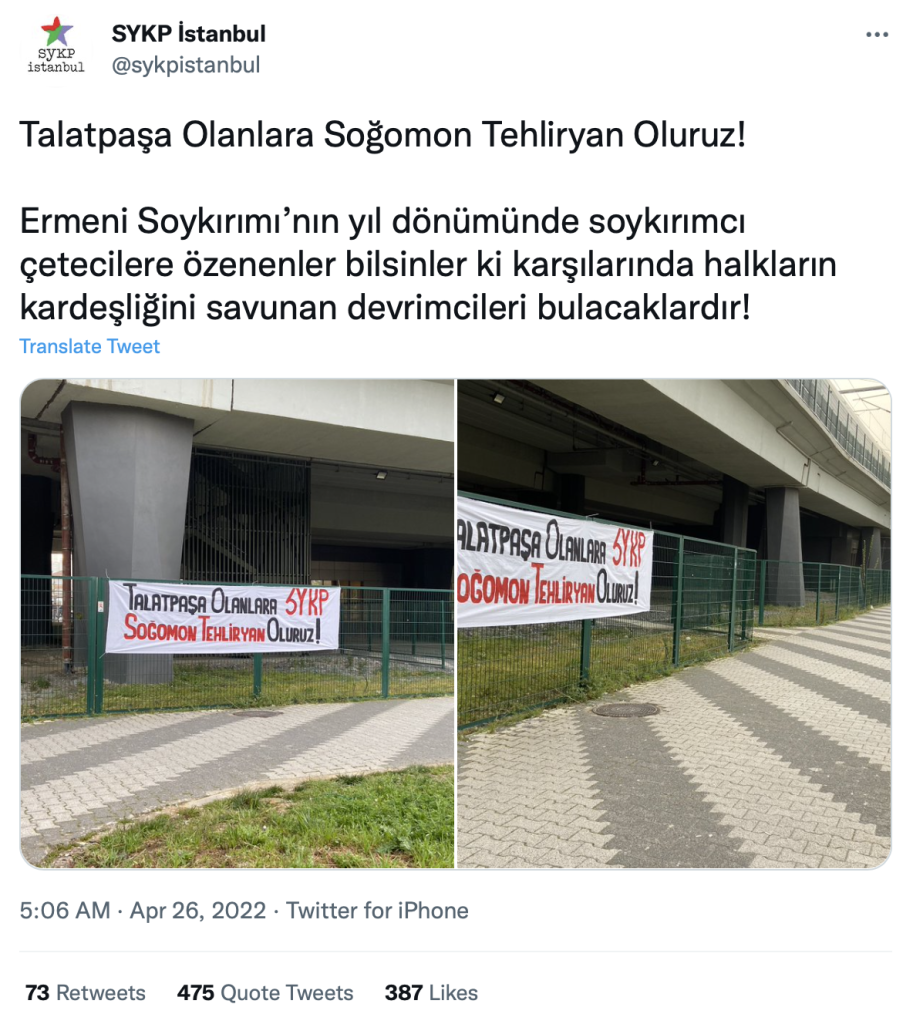
We can be certain that similar social media encounters will repeat themselves on June 2-3, the 101st anniversary of Soghomon Tehlirian’s acquittal at the Berlin court. Tehlirian, as a hero, is even more popular in Armenian culture than Talat is in Turkey, as Tehlirian’s celebration is barely challenged from within, except for some public statements by his son, who wants to avoid the heroization his father by nationalists.[vii] Since the prospect of retributive justice remains dismal, Tehlirian’s story offers his commemorative community a symbolic salvation that honors the martyrs of 1915 through the notion of revenge. Ever since the Armenian terrorism of the 1970s, Tehlirian’s image has been weaponized by Armenian nationalist speech acts because he uniquely represents the notion that through revenge Turkish crimes will receive due punishment and Armenian suffering its due legal recognition in return. Needless to say, this celebration of violence and revenge not only hindered genocide recognition in the 1980s but still constitutes a toxic dialectic in today’s social media encounters and nationalist celebrations. The celebration of Tehlirian as a hero in the recent outburst of the Nagorno-Karabakh conflict between Armenia and Azerbaijan demonstrates that the Talat-Tehlirian complex can be flexibly utilized beyond Turkish-Armenian relations.[viii]
To conclude, my intellectual encounter with the critical study of heroes has helped me deal with the problematic reputational legacies of transgressive actors between history and memory.[ix] Heroic imaginaries can hold historical research hostage for ransom in return for a transaction in expected categories of heroes, villains, perpetrators, and victims. The life history of transgressive actors needs to be studied beyond, but not in spite of, their continued heroization and villanization for their violent pasts. While the teleological and moral imperative of genocide research reduced Talat’s reputation to his role in the genocide, in order to counter banal denialism, it also complicated the study of his life history before and after the genocide. Similarly, there is almost no study of Operation Nemesis that clearly avoids nationalist tropes of either heroism and revenge, or terrorism and trickery, instead embedding its story as part of a transnational struggle for justice and sovereignty in the international order. As complex heroic archetypes, I have argued that the pairing of martyrs and avengers is a compelling and enduring configuration in sustaining conflicts and sacralizing violence.[x] Therefore, I advocate a post-heroic parting not only with the Talat-Tehlirian complex but also a critical reflection on any other form of sacralization of martyrdom and revenge in post-conflict societies.
[i] I consider Tehlirian, who was a soldier in the Armenian Voluntary Battalions of the Russian Army during the war, still a survivor since he lost his whole family in Erzincan during the deportations and massacres.
[ii] I shared this episode in the conclusion of PhD thesis entitled “The Young Turk Aftermath: Making Sense of Transnational Contentious Politics at the End of the Ottoman Empire, 1918–1922,” (University of Basel, 2016; available online since 2019: https://doi.org/10.5451/unibas-007110817), 506. These conspiracy theories about the “Young Turks” being “crypto-Jews, Freemasons, and Zionists” date back to Orientalist and anti-Semitic British intelligence reports, which were later discovered and rehashed by Islamist scholars who blamed the Young Turks for the loss of Ottoman Palestine. See: Maurus Reinkowski, “Late Ottoman Rule over Palestine: Its Evaluation in Arab, Turkish and Israeli Histories, 1970–90,” Middle Eastern Studies 35, no. 1 (1999): 74–5; Alp Yenen. “Elusive Forces in Illusive Eyes: British Officialdom’s Perception of the Anatolian Resistance Movement.” Middle Eastern Studies 54, no. 5 (2018): 790–91.
[iii] https://twitter.com/ilker_ayturk/status/1518264480869896193; https://twitter.com/ilker_ayturk/status/1503672983117864964;https://twitter.com/ayayciog/status/1518304204191940609
[iv] “Vatan Sana Minnettardır,” April 24, 2022, https://twitter.com/umitozdag/status/1518075020861448192
[v] “Talatpaşa Olanlara Soğomon Tehliryan Oluruz! Ermeni Soykırımı’nın yıl dönümünde soykırımcı çetecilere özenenler bilsinler ki karşılarında halkların kardeşliğini savunan devrimcileri bulacaklardır!,” April 26, 2022, https://twitter.com/sykpistanbul/status/1518879160877334528
[vi] “Pek az rastlanır bir durum @alp_yenen’in şu çok değerli makalesi resmen sokaklarda, sosyal medyada sahneleniyor,” April 26, 2022, https://twitter.com/yektantyilmaz/status/1518919630739361796
[vii] Tim Neshitov, “Der Adler: Rächer für Völkermord an Armeniern,” Süddeutsche Zeitung, March 20, 2015. https://www.sueddeutsche.de/politik/voelkermord-der-adler-1.2442261; Robert Fisk, “My Conversation with the Son of Soghomon Tehlirian: The Man Who Assassinated the Organiser of the Armenian Genocide,” Independent, 20 June 2016, http://www.independent.co.uk/voices/robert-fisk-armenian-genocide-conversation-son-of-soghomon-tehlirian-mehmet-talaat-pasha-a7091951.html
[viii] This is nothing new since the Operation Nemesis that assassinated Turkish perpetrators and Armenian traitors also targeted Azerbaijani officials Fatali Khan Khoyski and Behbud Khan Javanshir, who were held responsible for the massacre of Armenians in the Caucasus during the Russian civil war.
[ix] I have especially benefitted from my collaboration with the Collaborative Research Centre (SFB) 948 “Heroes – Heroizations – Heroisms: Transformations and Conjunctures from Antiquity to the Modern Day” at the University of Freiburg. https://www.sfb948.uni-freiburg.de/en
[x] For the heroization of martyrs, see Olmo Gölz, “The Imaginary Field of the Heroic: On the Contention between Heroes, Martyrs, Victims and Villains in Collective Memory,” helden. heroes. héros., special issue 5 (2019): 27–32, https://doi.org/10.6094/helden.heroes.heros./2019/APH/04; Olmo Gölz, “Martyrdom and the Struggle for Power: Interdisciplinary Perspectives on Martyrdom in the Modern Middle East,” Behemoth—A Journal on Civilisation 12, 1 (2019): 2–13, https://doi.org/10.6094/behemoth.2019.12.1.1013.
